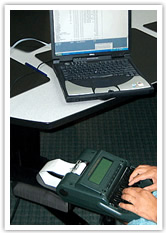 A common question I am asked by attorneys is “When can I expect to get my transcript?”
A common question I am asked by attorneys is “When can I expect to get my transcript?”
I thought I would take the opportunity to answer this question here in case you are wondering how long it takes to receive a transcript after a legal deposition has been taken.
When an attorney takes a deposition, the average time it takes a court reporter to finish a transcript and deliver it can be 10 days to two weeks. At O’Brien and Bails we strive to deliver transcripts in 10 days.
How to ensure you get your transcript on time
- Before leaving the deposition, request that a transcript be prepared. If this is not possible at the deposition, then as soon as you know you will need a transcript, call the court reporter to make the request.
- If there is a specific date or if you need a deposition sooner than the normal turn-around period, be sure to notify your court reporter as soon as possible.
- Follow up with the court reporter if you have any questions regarding the expected delivery date of your transcript.
- If you do not see your transcript within 2 weeks, you should contact your court reporter to inquire.
How a transcript is prepared
Understanding the transcription process may help you understand the issues involved in creating a timely transcript.
When proceedings are over and a transcript is ordered, the court reporter returns to the office, accesses the digital file, and reads through the entire proceedings to ensure accuracy. Any areas that did not translate correctly need to be edited. The reporter will compare steno shorthand notes to the translation to ensure accuracy.
A reporter will also pull information from many sources in order to make sure the transcript is as accurate as possible. For instance, they may do research on the Internet, they may contact the legal assistants involved in the case for specific spellings of names that are involved in the case if they are unable to find the information on the Internet, or they make look in reference material in order to make sure they have the terms spelled correctly.
Once finished editing, a court reporter then carefully reads through the transcript again to proofread for spelling or typographical errors.
Some reporters proofread the transcript a second time if the testimony involved technically complex subject matter.
The next step is the production aspect, which involves printing the transcript and also putting the transcript through several different computer programs in order to make it available electronically in many different formats. Exhibits are scanned in order to link them up electronically to the transcript so they are available, along with printing/copying the exhibits so they are available in hard copy. Then the transcript and exhibits are uploaded to a repository that can be accessed by the attorney/legal assistant, and also many times delivered electronically to the ordering parties.
Because there are several steps involved in preparing an official transcript, a court reporter has several things to consider when a rush transcript is ordered. A reporter will often have other transcripts to finish before she or he can work on finalizing yours. Special arrangements need to be made to juggle transcript deadlines. That is why having advanced notice of a rush transcript order allows a reporter to make special arrangements to clear out his or her previous workload so your transcript can be finalized more quickly.
Receiving your transcript when you need it
Court reporters understand there are circumstances under which you may need a transcript faster than the normal turn-around time. If we know you have a need for your transcript by a certain date, every effort will be made to meet your request. It can be common for court reporters to work through the night to make a transcript available the next day when they are requested. A good rule of thumb is that it takes two to three hours to finalize a transcript for every hour the reporter writes the testimony at the deposition.
At O’Brien & Bails, we are dedicated to getting you the transcript when you need it!
If you would like to schedule an O’Brien and Bails court reporter for your next deposition, use our Deposition Scheduler online.
 I grew up in Detroit, and went through Detroit Public Schools when the schools were first rate. I had an older cousin growing up who went into the profession of court reporting and did very well. He always wanted me to go into the profession, and in 1975, after 18 months, my teacher at Macomb College, Mr. George Jackson, thought I was ready to work. And so I began working two days a week in Romeo District Court reporting arraignments. Being in front of a courtroom the size of a large bedroom with 50 suspected drinkers and drug offenders was one of those moments when you say to yourself “What am I doing here?”
I grew up in Detroit, and went through Detroit Public Schools when the schools were first rate. I had an older cousin growing up who went into the profession of court reporting and did very well. He always wanted me to go into the profession, and in 1975, after 18 months, my teacher at Macomb College, Mr. George Jackson, thought I was ready to work. And so I began working two days a week in Romeo District Court reporting arraignments. Being in front of a courtroom the size of a large bedroom with 50 suspected drinkers and drug offenders was one of those moments when you say to yourself “What am I doing here?” From time to time we get asked the question, “How much does it cost to hire a court reporter for a legal deposition?” Often this question comes from a new attorney, a legal assistant, or a plaintiff or defendant not familiar with litigation practices. To answer the question, let’s first define “legal deposition.”
From time to time we get asked the question, “How much does it cost to hire a court reporter for a legal deposition?” Often this question comes from a new attorney, a legal assistant, or a plaintiff or defendant not familiar with litigation practices. To answer the question, let’s first define “legal deposition.” Before becoming a court reporter, have you ever worked in other jobs or fields?
Before becoming a court reporter, have you ever worked in other jobs or fields? Since 2008, the State of Michigan has offered tax incentives to entice film studios to bring their work to Michigan. The Ingham County Courthouse in Mason reaped the benefits of those incentives last July when Amblin Entertainment and Dreamworks Studios filmed scenes using the courthouse for an upcoming movie starring Hugh Jackman.
Since 2008, the State of Michigan has offered tax incentives to entice film studios to bring their work to Michigan. The Ingham County Courthouse in Mason reaped the benefits of those incentives last July when Amblin Entertainment and Dreamworks Studios filmed scenes using the courthouse for an upcoming movie starring Hugh Jackman.